Wrangell St. Elias, the Northern View
Wrangell-St.Elias, a ridiculously long name for a park. Did they figure that the biggest preserve in the world needed lots of extra syllables? Hard to say for sure.
As I posted previously, this area is a huge space of 13 million acres, but in addition, it is contiguous with Canada’s Kluane National Park, BC’s Tatshenshini-Alsek Provincial Park, and Alaska’s Glacier Bay National Park. All put together, they comprise about 40,000 square miles (100,000 square kilometers) of very special wild space. Here’s a peek at the northern extent as we drive up the Richardson Highway toward Slana.
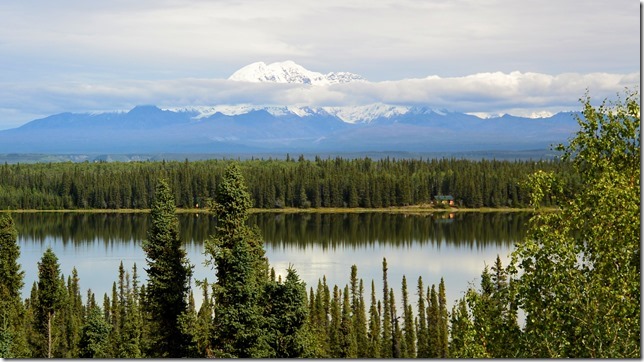
The real key to WSE and its siblings is the focus on multi-use of wilderness areas. For instance, motor vehicle access is permitted in some areas. In Preserves, hunting is allowed, and subsistence hunting is allowed in both Park and Preserve. Grandfathered private lands are sprinkled here and there. In short, it’s a more accessible wilderness than the highly restricted types found in the lower 48. The slant of the ANILCA agreement was to consider that humans could be considered to be part of Nature, and (with appropriate controls and regulations) coexist in an ecologically balanced way.
So, for example, Resident Alaskans can subsistence-hunt – but they must report their kills and catches so that wildlife management agencies can keep track of populations and make sure they are on healthy status. There is a lot more to this, and I’m just using this one feature as an example.
My previous post covered the McCarthy access road in the southern section of WSE. You can read that post HERE###. This time, we went in on the northern access, Nabesna Road. The sole original purpose of this road was mining access, to a private mine that is still in operation (another example of multiple use). Today, it provides access for tourists, miners, and residents. Sadly, today (literally) the whole Park is shrouded in a dense weather system and we are being again cheated out of some truly fine scenery. Fortunately, there are occasional breaks in the weather, so although we don’t find any sun, we do get some glimpses of the giant mountain peaks that surround us.
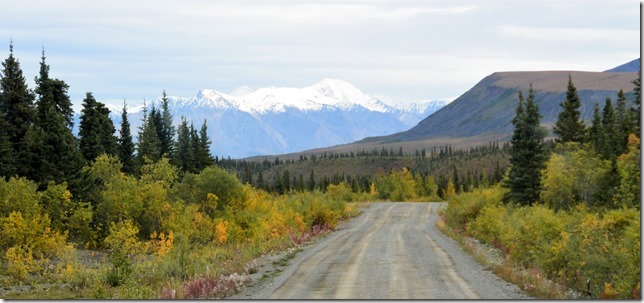
We found ourselves reminded of the wild, remote nature of Denali (deep in the Park). But here in WSE, we have our own vehicle, very few restrictions, no tour buses and not very many people. We took Howie and Ralph 28 miles down a bumpy dirt/mud road, and found a fine campground at Two Lakes. Beautiful, lonesome, wet, gray, wild. One other camper on the other side of the campground. The only sounds were the wind and the rain on our roof.
This is hard, plain country. Residences here tend toward the Spartan, with perhaps a touch of sourdough.
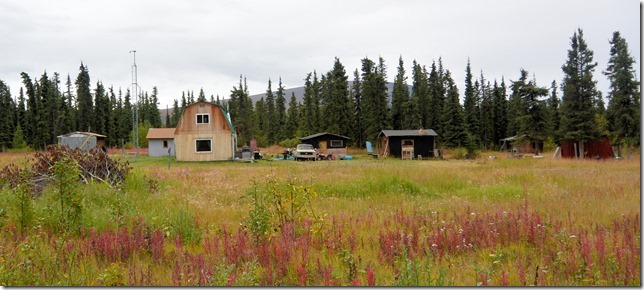
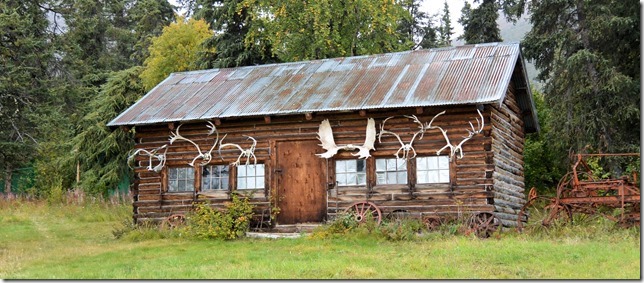
Airfields aren’t fancy either. This one is about three times longer than what’s shown in the picture. Maybe 1000 feet. Maybe. Note there are only super-short-field aircraft working this place.
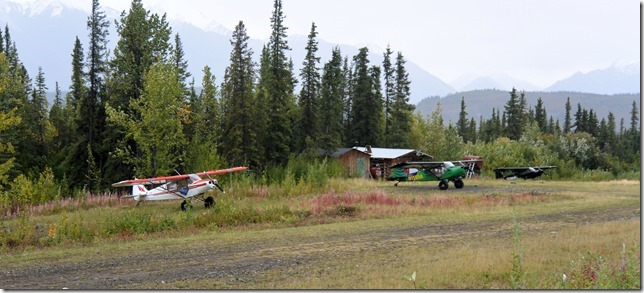
Now, if it’s a commercial place, like this guided hunting lodge – well, then you can afford to spruce things up a bit. I’m not sure what the white fence is for, but I guess it dresses the place up a bit.
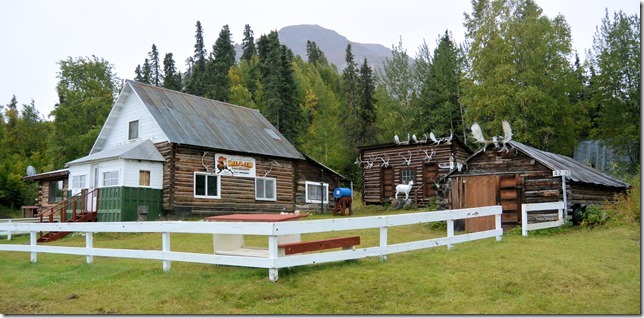
But most of the place is completely un-touched, just open wild country without a fence or structure in sight. Literally thousands of square miles of it. I wish there were some sunshine to show it off a little, but no such luck.
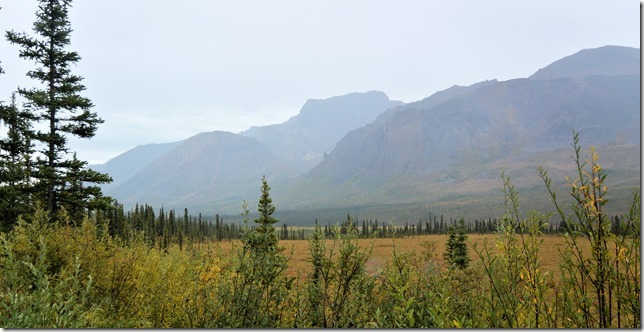
The namesake Nabesna mine is privately held, but it’s possible to hike up to it, which we did in a drenching cold rain. A steep muddy trail took us just a half-mile up a mountain-side to the dilapidated (but functional) structures. Some were new-ish…
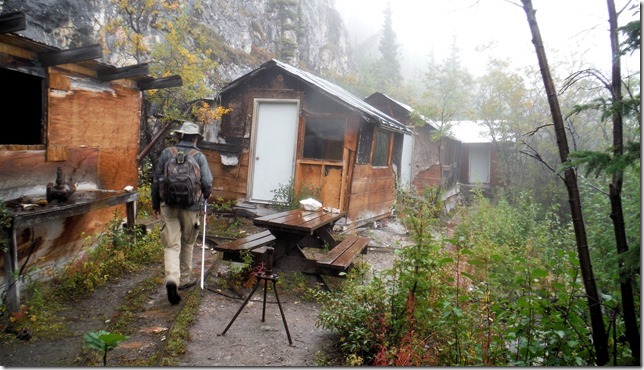
…and some considerably more aged.
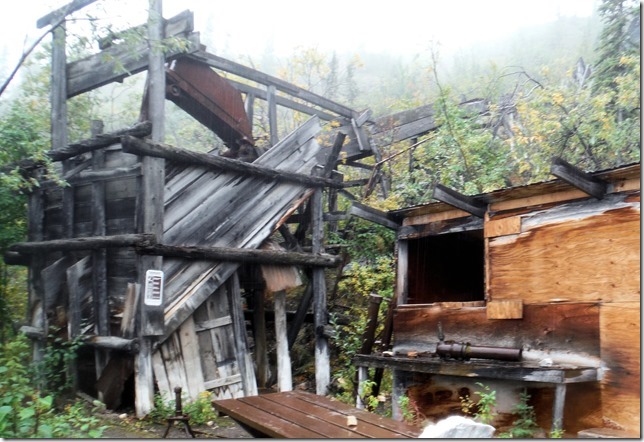
The mineshaft was gated off, but who’d be crazy enough to go in there anyway? (Turns out, there’s a high idiot percentage among tourists. Mines, cliffs, and moose all take their toll every year.)
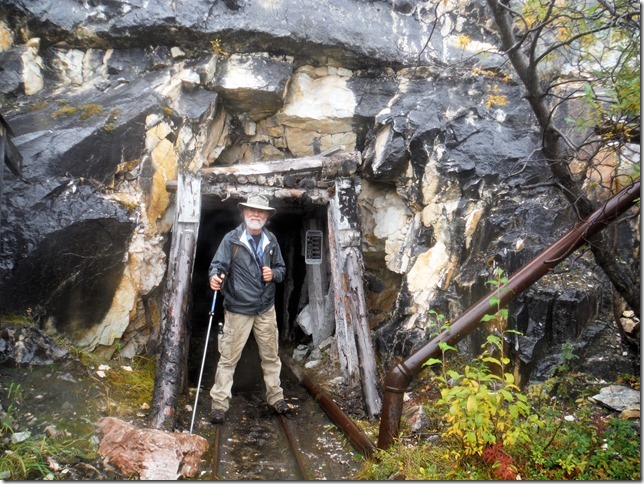
Leaving the mine and returning to the access road, we saw that the day’s rains were taking their toll. The road was becoming increasingly challenging. Ralph’s 4WD and high clearance were more than capable of handling this kind of stuff, but a regular street vehicle could see some difficulties.
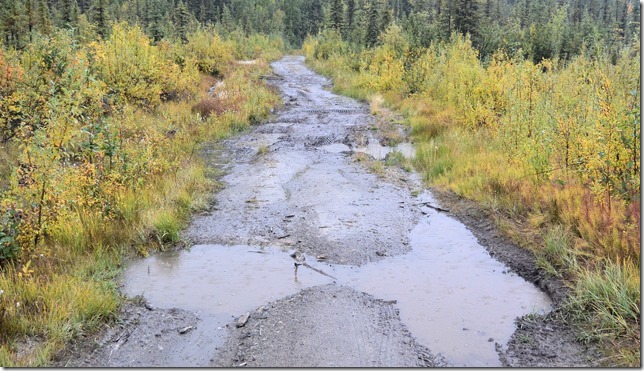
We had come in about 15 miles further than where Howie was camped, and we took our time going back out. We were actually enjoying the weather – it gave the area some menace, but it also emphasized the un-tamed character of the region, and the hardiness of people who choose to live there.
Along the way, we ran into a young couple from Wasilla, just coming back from a successful week-long sheep hunt. (Hunters are only allowed to take the older rams, indicated by horns grown in a full circle. This ensures a reasonably long breeding life. The well-managed Dall sheep population numbers about 15,000 in WSE.)
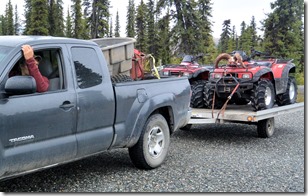
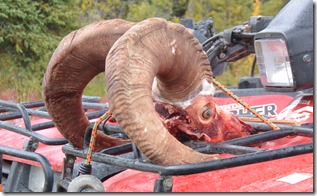
Later, we crossed a shallow river and found these guys on the other side, pumping up a full-size river raft with a little bellows foot pump.
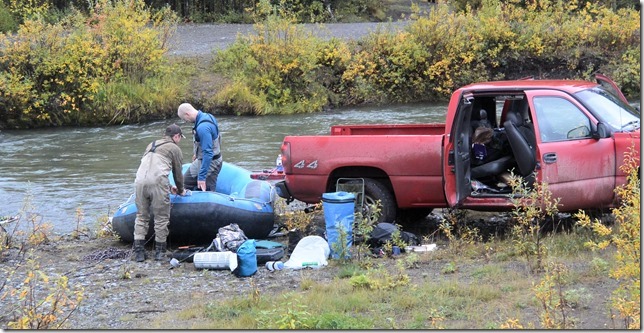
They were setting up to take off on a hunt, so I went down to chat with them for a few minutes. They were out of Soldotna (Kenai Peninsula), and were headed out for ten days hunting. The plan was to push and drag the raft through the shallow stream, intersect with the larger Nabesna River, and float down two days to a to-be-determined hunt camp. There, they would stay and hunt Dall sheep for a week or so. Another two day float would take them further down-river to Nabesna (near the mine we just came from) and their other vehicle. Pack up, come back and pick up the truck and head on home. Weather was forecast at 40’s in the days, 30’s at nights, with intermittent rain and snow. Just another Alaskan autumn hunt.
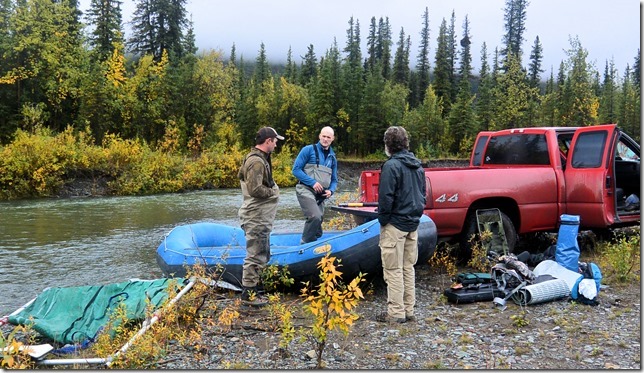
That night, snug, warm, and dry in Howie with rain pouring down, we thought of them and wished them well.
Across from our camp was a classic example of the “drunken forest” syndrome. This is seen everywhere across the tundra and permafrost areas. Permafrost melts and freezes, and the ground and surface soils changes their levels and angles. These spruce trees tilted over when the ground they were growing in melted and shifted. Likewise, the previously level gray-gravel camp site became a potato chip with a pond when the ground it was laid over wrinkled with melt/freeze cycles.
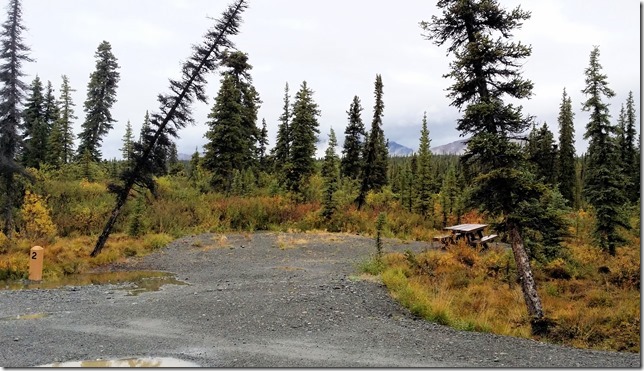
It rained like a fire hose all night, non-stop. The next morning, we weren’t really sure of conditions on that long dirt road back to the highway. Everybody knows the time-honored equation: Dirt + Water = Mud.
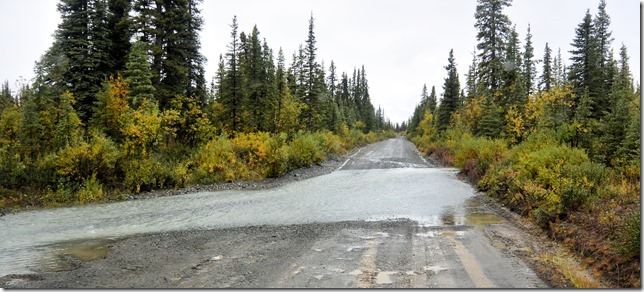
We stayed un-hooked and put Karin and Ralph out on point guard. They ran ahead to check out the surfaces before I took a chance to drive Howie’s big lead butt through any obstacles. We didn’t encounter anything really nasty, just a lot of soupy potholes, and all four of us made it out just fine – just a little more dirty.
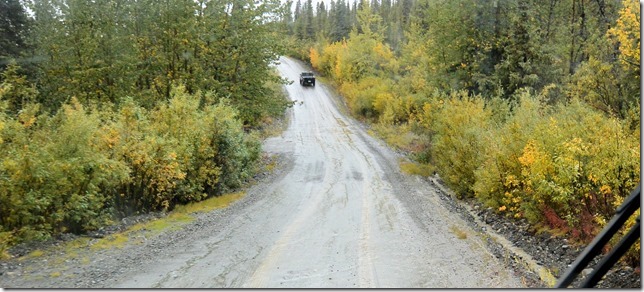
What a mix of images and colors greeted us on that morning trip out of the Park. The sullen gray sky remained overhead, but high enough to reveal the new mantles of snow atop the mountains. Pinks, light and dark, glowed unrelentingly from the fireweed, a plant which seems to find neon expression in every season. The greens are still rich, but entire hillsides are turning russet and yellow as the North’s early Autumn descends on us.
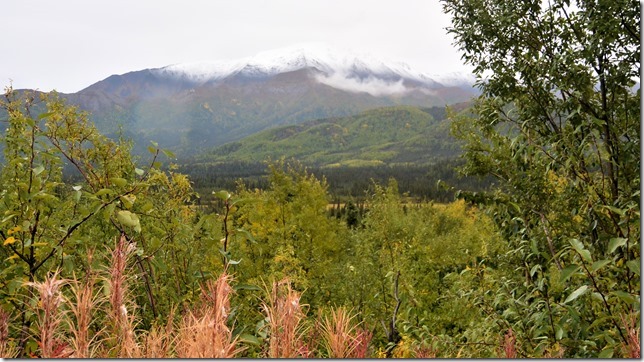
We’ve gotten the message, and we’re running away like the good California wussies that we are. We will head east to Tok and pick up the Alcan for most of our journey through Canada. With the weather always in mind, we’ll have only scant time to explore the 2,000 miles we want to traverse before the end of September.
And that doesn’t even count the northern states (Idaho, Montana, Wyoming, Oregon, ??) we might pass through on the way home. Gee, I guess that means we’ll have to come back again for the details. Not a bad thing.

“Horrible road” does not sound good! Really appreciate the helpful input. We leave next week so watching the weather closely. Wind here really bad.
Thanks again.. .safe travels.
Aurora rated a 5 tomorrow !
More specifically — we probably hit 20-30 miles of fast gravel with occasional potholes on Tok-Donjek
Alcan. On the TOW highway, there is 100 miles of dirt/gravel with widely variable surface, sometimes quite nasty, 20mph stuff. Add water and it’s likely to be MORE nasty. I’m glad we went TOW, but the Tok Alcan is beautiful too. Also — farther north could have some snow.
Vey helpful Thanks! We went over in 07 so both ways so not like we haven’t. like we haven’t seen TOW and sounds like better to avoid this trip. Tok-Destruction Bay was Horrible then. It does have beauty as well like you say. we are headed to North Pole to check out the Aurora before we heada out so wet weather will probably be a factor. Colors are really changing. Enjoy the Rockies.
OThanks for a glimpse of this area. Love seeing the color changes. Also glad you got to see some of the cool things inn Valdez through the crowds. Thankfully they have greatly diminished. Blew away with that HUGE windstorm maybe? !
We are interested in your impression
of the roads & conditions from the AlCan border to Whitehorse for us about to follow….Thanks again for all the great pics and adventures you’ve shared so far. Be safe on the road and keep eyes out for the Aurora:)
Rats, no Aurora yet through all these dang clouds.
Alcan 1 from Tok to Donjek River is a mess, miles and miles of construction (gravel and dirt). Slow travel and very sloppy when wet. After the river, things smooth out. Apparently it’s been that way for years. Plan on about 30-40mph average on this stretch. Lots of stops and waits too, about 20 minutes for the longest one.
Thanks for the info. We are trying to decide whether to head out that way or “Over the Top” for a change. We haven’t been that way for a few years. what to you think in comparison?
Good Aurora activity forecast for Wed -Friday., Hope you guys are somewhere clear in an active area like Whitehorse or Watson Lake. Nice place we found last year in the Canadian Rockies is Toad River. Good stop for WIFI & Laundry etc. campin / kayak on a nice active beaver pond with lots of excellent views & wildlife in an old roadhouse setting. Easy to miss on the road but we think its a hidden gem. Be safe & thanks again for your posts and input.
I’m just writing this up for my next post – – I rate the Tok drive and Top-o-World equal in scenic beauty. TOW is horrible road compared to Tok, even with construction. But both are worth the drive for sure. This time of year (and weather) might be snow issues farther up north though.